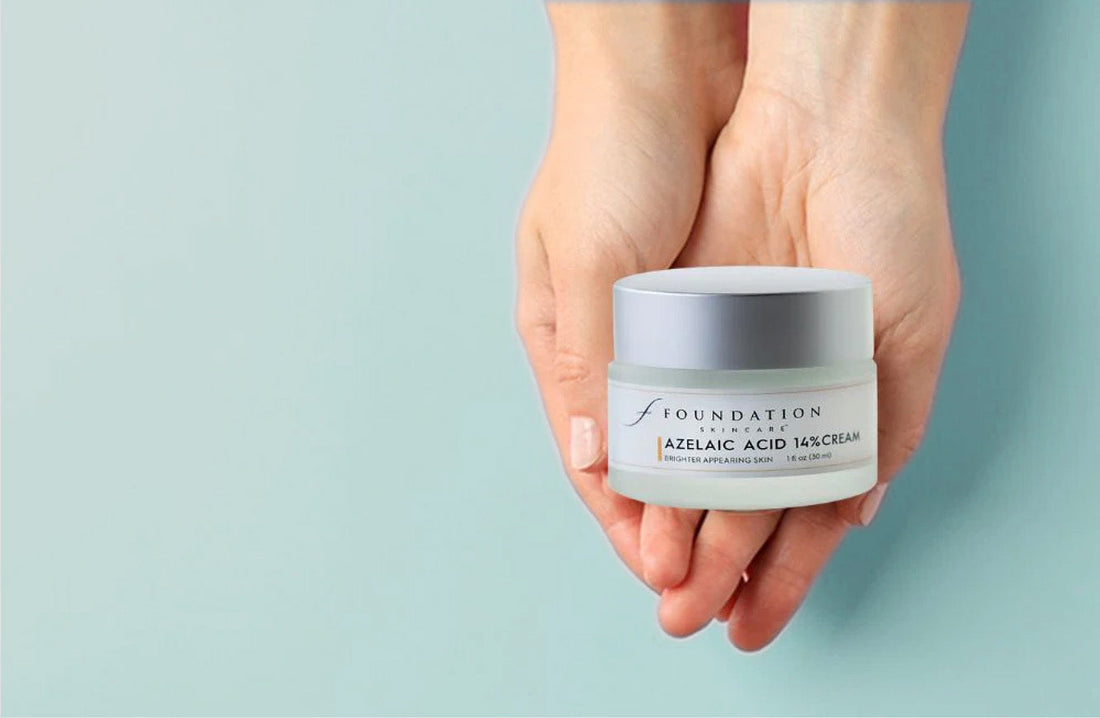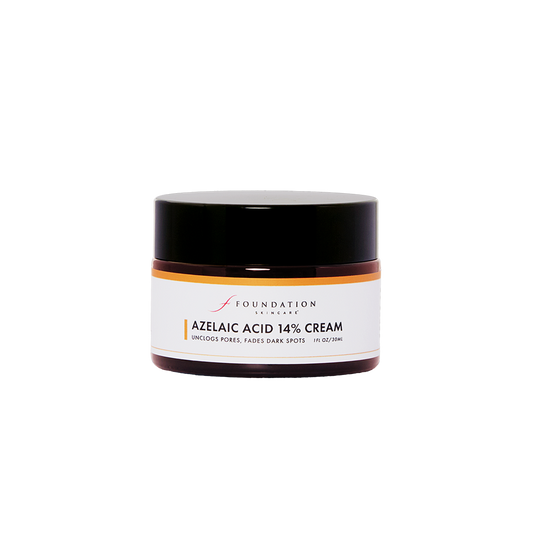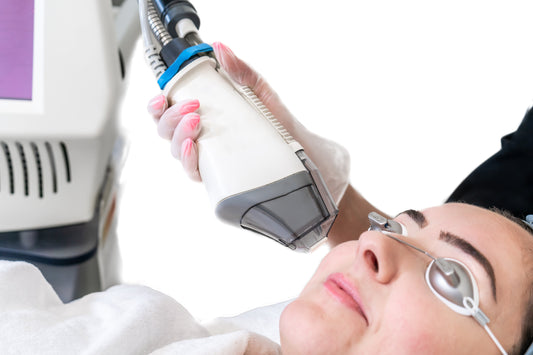One of the lesser-known active ingredients in many skin care products is azelaic acid, a natural byproduct of yeast that has amazing benefits for human skin. To learn more about how to use this natural ingredient to treat a variety of conditions, read on.
What is Azelaic Acid?
Azelaic acid is a dicarboxylic acid, and is a naturally occurring substance produced by the beneficial yeast on our skin. It is also found in grains such as barley, wheat, and rye. Azelaic acid supports skin health in a number of ways, thanks to its antimicrobial, anti-inflammatory, and antioxidant properties. This makes it an ideal treatment for skin conditions like acne, hyperpigmentation, and rosacea.
As a topical exfoliating treatment, azelaic acid can be used to treat a variety of skin conditions. Dermatologists recommend it to treat and prevent mild to moderate forms of acne, diminish dark spots, and minimize inflammatory rosacea lesions. Azelaic acid is also a powerful antioxidant that can counter or neutralize the harmful effects of free radicals.
What are the Benefits of Using Azelaic Acid Cream?
Considered safe for use with all skin types, the Foundation Skincare Azelaic Acid Cream is used to calm inflammation on the surface of the skin, as well as to help clear blemishes, diminish redness, and kill acne-causing bacteria.
Azelaic acid has antiseptic and keratolytic properties, and works much like benzoyl peroxide and salicylic acid to unclog pores and clear skin. However, it is less abrasive and gentler to the skin than these ingredients. Its keratolytic properties make it useful as an exfoliant and comedolytic agent, so it is effective at unclogging pores, drawing out whiteheads and blackheads, and helping to prevent future breakouts.
Azelaic acid also assists the process of cell turnover by clearing away dead skin cells and excess oil. It also triggers collagen production and promotes the regeneration of healthy new skin cells. This makes it a suitable solution for brightening, improving uneven skin tone, and diminishing the appearance of acne scars.
Available without a prescription, Azelaic Acid Cream is an effective alternative to controversial medications like hydroquinone. Because Azelaic Acid is gentler on the skin and causes less dryness and irritation compared to other exfoliating agents, it's also recommended for individuals with dry or sensitive skin.
How Does Azelaic Acid Work?
Azelaic Acid is effective at helping improve various skin conditions in the following ways:
Azelaic Acid for Acne
Acne is caused by a number of genetic, hormonal, nutritional, and environmental factors. Dead skin cells, sebum, and impurities can clog pores. As bacteria accumulates on the skin, it may trigger inflammation and infection in these clogged pores, leading to acne.
Clinical studies have shown that the use of a cream containing azelaic acid can kill acne-causing bacteria on the skin. Azelaic acid can also slow down the production of skin protein, which reduces the ongoing buildup of dead skin cells. As an antioxidant, azelaic acid can also counter or neutralize the effects of harmful free radicals that may cause irritation and inflammation in the skin.It also accelerates the skin’s cell turnover process, triggering collagen production to repair damaged skin.
Azelaic Acid for Melasma and Hyperpigmentation
Individuals with melasma or hyperpigmentation, two conditions characterized by dark patches on the skin, can also benefit from using Azelaic Acid Cream. Azelaic acid inhibits tyrosinase, an enzyme required for the production of melanin in the skin. Because it affects the natural production of melanin, azelaic acid is effective at lightening the skin and diminishing the appearance of hyperpigmentation.
Azelaic Acid for Rosacea
Azelaic acid has also shown effectiveness in improving rosacea, thanks to its anti-inflammatory properties and its ability to soothe redness, decrease inflammation, and calm painful rashes.
Azelaic Acid Cream by Foundation Skincare
The Foundation Skincare Azelaic Acid Cream contains an effective 14% concentration of azelaic acid, which makes it strong enough to show results, yet gentle enough to be used without a prescription. Many prescription-based azelaic acid formulas are made with a gel base, which can be drying and irritating. In order to give the skin the hydration and comfort it needs as the azelaic acid gets to work, we offer our formula as a water soluble cream solution. This makes it a cosmetically elegant formula that can be used both morning and night. Compared to other brands, our Azelaic Acid Cream ultimately feels better on the skin and is offered at a much better price point, all without compromising the quality.
Azelaic Acid 14% Cream
• Brightens skin, fades brown spots
• Unclogs pores, improves texture
How Often Should You Use Azelaic Acid?
The most effective way to use azelaic acid is as a topical agent that comes in the form of creams, foams, lotions, or gels. These formulations typically instruct you to apply them twice a day to clean, dry skin, although some products are not recommended for daily use. It is considered safe to use azelaic acid up to twice daily, and doing so is the best way to achieve optimal results from the formulation.
Our Azelaic Acid Cream is formulated to be safely layered with other skincare products, making it an easy product to implement into your morning and evening skincare routines. Prior to applying this cream, you’ll want to apply any serums or treatments to clean, dry skin. If you’re looking to help improve radiance while protecting the skin against the damaging effects of free radicals, we recommend the Foundation Skincare Vitamin C Lotion, which can be applied twice a day. In the evening, you can apply the retinoid-powered Foundation Skincare Night Renewal Cream to help minimize signs of aging and improve skin tone.
After applying any serums or treatments, you can follow up with a moisturizer (such as our Hyaluronic Acid Lotion) for an extra boost of hydration. You can then top that off with the Azelaic Acid Cream (in both the morning and night). During the day, your sunscreen will be the very last step in your routine.
Azelaic acid is generally considered safe to use with most other skincare ingredients. However, you may want to practice caution when using it alongside ingredients that have a higher risk of irritation, especially if you have more sensitive skin. This includes chemical exfoliants (such as beta hydroxy acids and alpha hydroxy acids) and retinoids. You may choose to use the cream in the morning and any other exfoliants or treatments at night, depending on your skin’s sensitivity.
While Azelaic Acid is a gentle ingredient that is safe and suitable for all skin types, you may wish to take your time adjusting to it. If you have sensitive skin or a delicate skin condition such as rosacea, you may begin slowly by using it on alternate days to start, and gradually increasing your use of the product to twice daily.
Who Should (and Who Shouldn’t) Use Azelaic Acid?
Azelaic acid is gentle enough that it’s safe for long-term use, and you may combine it with most other skincare ingredients. Azelaic acid is a category B drug, and is safe for use if you are pregnant and/or breastfeeding. Still, a small percentage of individuals may be sensitive to this ingredient, and if you have concerns about whether it is safe for you to use it, you should consult with your doctor.
Related Articles: Azelaic Acid Gel vs. Cream: What’s the Real Difference?, Best Ways to Use Azelaic Acid, Azelaic Acid 10% vs. 14%: What’s the Difference?
How Long Does it Take for Azelaic Acid to Work?
The Azelaic Acid Cream can take between 6-8 weeks to produce visible results. At this point you may notice a reduction in redness, fewer flare ups, and a softer complexion. Your complexion may continue to improve through the 3 month mark, where you may also notice a positive change in uneven texture and hyperpigmentation, as well as reduced inflammation.
Keep in mind that regular use is essential. While twice a day application is ideal for achieving the quickest results, adjust the routine as you see fit for your skin’s needs. With consistent use, our Azelaic Acid Cream can help you work towards fewer breakouts and flare ups, and can also help promote a more even skin tone and texture, as well as a more radiant complexion.






